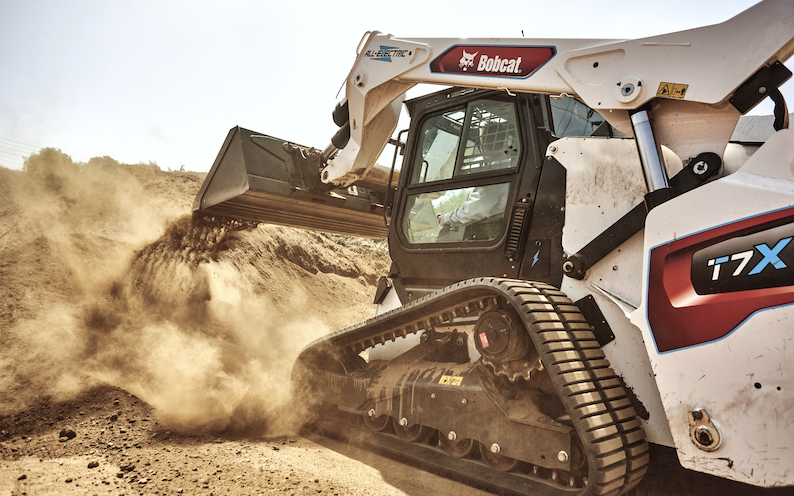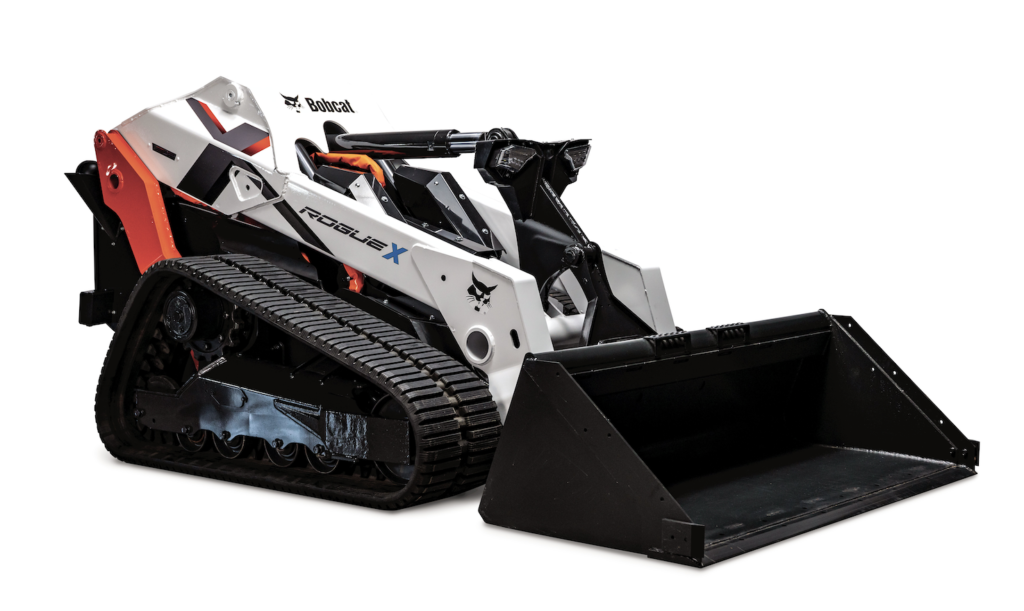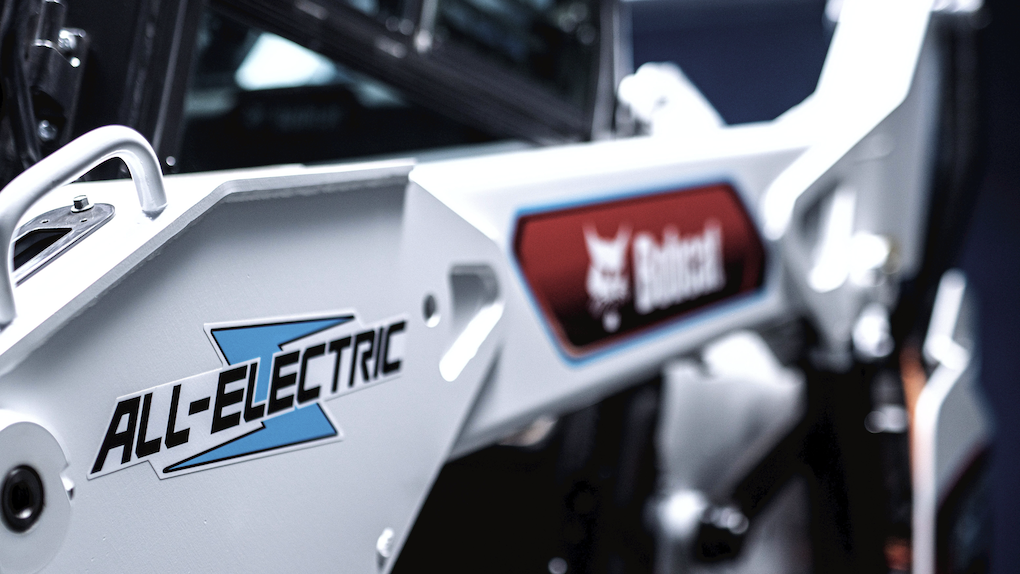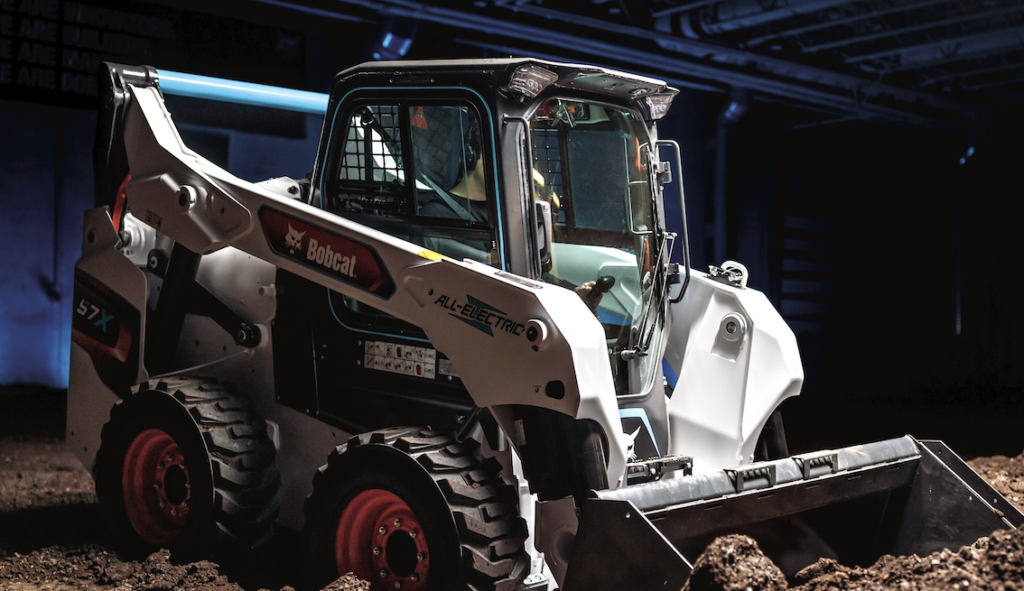There has been much talk in recent years about ditching hydraulics in off-highway vehicles in favour of fully electric systems. Now as Bobcat makes the concept a commercial reality, iVT’s Anthony James takes a look at exactly how it’s been done, the components necessary and asks; where next for this new aspect of electrification?
***
Bobcat, the company that kick started the compact equipment revolution of the 1960s following the launch of the M400, the world’s first true skid-steer loader, is now seeking to shake things up again with a shift towards fully electric vehicles that also eliminate hydraulic systems, components, emissions and vibrations to provide cleaner, quieter machines.
Having unveiled its new all-electric Bobcat T7X compact track loader – featuring electric actuators instead of traditional hydraulics – at CES 2022, the US-based OEM debuted two more machines featuring electric actuators at the recent ConExpo in Las Vegas – one concept and one ready for market.
 ABOVE: The all-electric Bobcat T7X compact track loader was originally unveiled in 2022
ABOVE: The all-electric Bobcat T7X compact track loader was originally unveiled in 2022
The market-ready model was the world’s first all-electric skid-steer loader, the Bobcat S7X; while the concept machine on show was a cabless track loader, the Bobcat RogueX, which explores the capabilities of electric power, autonomous operation and dual lift-arm geometry.
Like the T7X, the S7X is all-electric, featuring a Viridi-supplied lithium-ion battery that powers electric drive motors and utilises ball screw actuators for lift and tilt functions, with instantaneous torque three times greater than traditional loaders. It can operate for up to eight hours on a single charge depending on the application, giving most operators more than a full day’s work when breaks and downtime are considered. A full charge takes approximately 10 hours.
“As the inventor of the original skid-steer loader, we are excited to take the machine that created the industry and reinvent it all over again,” says Joel Honeyman, Doosan Bobcat’s vice president of global innovation. “The S7X can support operators on environmentally sensitive sites, in noise-restricted areas and for indoor operation.”
Closely resembling a track loader, the all-electric, zero-emission RogueX is part of an R&D project to evaluate customer perceptions and test the limits of machine functionality.
“RogueX was concepted with consideration for the worksite of the future and how a customer’s needs may evolve – with a focus on ease of use, remote operations, autonomous functionality, sustainable operations and features that allow operators to accomplish more with one machine,” continued Honeyman.
Bobcat has completely removed the operator station from the RogueX, in recognition of how jobsites are likely to change, with operators increasingly turning to remote operation. By building the loader without a cab and switching out traditional hydraulics in favour of an electric drive system to deliver advanced kinematics, Bobcat claims the RogueX is able to offer both vertical-path and radial-path lift capabilities in one machine.
Intelligent electrification
To bring both the S7X and RogueX to life, Bobcat once again partnered with Moog Inc, which it also worked with on the earlier T7X. Moog’s intelligent machine electrification system features on all three platforms, combining an integrated software framework, a sophisticated electric machine controller, lift and tilt electric cylinders, electric traction motors, and power electronics.

ABOVE: The Bobcat Rogue X concept has no cab and switches out traditional hydraulics in favour of an electric drive system to deliver advanced kinematics
Bobcat had a vision for an all-electric machine,” explains Joe Baldi, director of strategy and partnerships for Moog. “Our conversation began with Moog’s all-electric actuators, but ultimately our talks led to the intelligent machine electrification system. Working in partnership with Bobcat, we were able to bring that all-electric vision to life in six months [starting with the T7X].”
The intelligent machine electrification system helps the T7X control the motion of the tracks, as well as lift and tilt functions: “To describe our contribution to the T7X in anatomical terms,” continues Baldi, “we supplied the part of the brain that controls motion; the nervous system helping to intelligently coordinate actions, power, and sensor information; and the muscles, which are the all-electric actuators and
the motors.”
How does it work?
Unlike other compact loaders, the all-electric T7X compact track loader and S7X skid-steer loader don’t rely on a hydraulic system to transfer power to the machine’s workgroup. Instead, they each feature a 60.5-kWh lithium-ion battery that powers two electric motors which drive the tracks/wheels. The battery also supplies power to four Moog ball-screw actuators (two for lift and two for tilt) that deliver precise power requirements to the workgroup.
The control system for the actuators is similar to the one used in current production Bobcat loaders with electric joysticks and hydraulic cylinders. Together, the battery and electrical system generate incredible performance characteristics and precise control.
 ABOVE: Both the Bobcat T7X compact track loader and S7X skid-steer loader feature a 60.5-kWh lithium-ion battery that powers two electric motors which drive the tracks/wheels
ABOVE: Both the Bobcat T7X compact track loader and S7X skid-steer loader feature a 60.5-kWh lithium-ion battery that powers two electric motors which drive the tracks/wheels
“Bobcat Company has been building loaders with electric joystick controls for over 20 years,” says Honeyman. “The electronic joysticks and machine controls are fully integrated into the T7X and S7X electrical systems. The intelligent power management system is programmed to sense workload requirements, and delivers the electrical power needed for the job at hand.”
Three unique control modes give operators the ability to tailor the workgroup and drive response, while discharging only the amount of power the operator needs. The joysticks can include fingertip controls for attachment operation.
“As the power and control systems are entirely electric, these loaders provide a virtually limitless ability to upgrade product features via software updates,” says Honeyman.
Fluid thinking
Switching to an all-electric powertrain to eradicate emissions was also the catalyst to ditch the hydraulic set up, with the team keen to exploit Moog’s experiences of supplying electric actuators to the aerospace sector.
“If we’re going to electrify a vehicle, we wanted to explore what other technologies we could potentially add to further enhance performance,” continues Honeyman. “Could we remove the hydraulics and find something else to enable the mechanical movement of the equipment? We started looking at different industries, especially the aerospace sector, which has been using electric actuation for a long time.”
 ABOVE: A full charge of the S7X skid-steer loader takes approximately 10 hours.
ABOVE: A full charge of the S7X skid-steer loader takes approximately 10 hours.
“There are many really nice attributes to a fluid power system, but then there are also drawbacks,” adds John Pfaff, Doosan Bobcat’s innovation engineering director. The latter include all the additional sensors and components required to enable certain functions, as well the issue of ‘dead band’ in non-linear control valves. With an electric motor control solution power is instantaneous and relative position and force is known in real time. This allows for programming to achieve the desired effect the operator is looking for without the need to compensate for lag and/or deadband in the system. To state this another way, motors provide max torque at zero RPM and the speed at which we can drive the motors exceeds what is required. The end result is ample reaction acceleration, speed and power to perform the function being programmed and then utilised by the operator.
“When we started this activity, we asked, ‘What’s the ultimate machine? What do we see in the future to get the level of control that we need, so we don’t have the dead band and all the struggles with how to incorporate the sensors into the system to keep complexity down,” continues Pfaff. “Normally, when a new feature is added to a hydraulic system, it requires additional sensors or plumbing and components to create that capability. Moving to an electronic system really does simplify things, turning it into a software platform that we can tune far more simply to make tweaks and
add capacity.”
Honeyman highlights an insanely fast development programme as proof of the platform’s greater efficiency.
“When we create a new vehicle with a new hydraulic system, we always get a customer in to give us feedback and see where we’re at, so we’re confident that we have something really good,” he says. “To get to that point takes time – on average, it’s at least a year of development activity. When we built the first T7X, it was literally two weeks before we were ready to get a customer, which really surprised us. For our drive control software engineer, who has been tuning hydraulic systems for years, this was his dream machine.”
As a result, Bobcat’s latest electric loaders boast some impressive new features: “We have a bucket shake feature, which is simply a button that you press on one of the joysticks, to rapidly shake the material out of the bucket – you can’t do that on a hydraulic machine, but you can do that with software,” explains Pfaff. “We also have what we call a ‘beast’ mode, activated via the joystick, which puts full current to the drives at certain positions and times, so when you’re going into a pile and digging, you can throw full current to those drives. You can’t do that with hydraulics – you can’t suddenly have more flow to a hydraulic system.”
Efficiency gain
However, by far the biggest benefit of the new approach is the significant improvement in operational efficiency and comfort:
“Compact [hydraulic] machines need a very large cooling package, as the fluid power is very power dense, albeit inexpensive, relatively, for what you’re getting out of it,” says Pfaff. “It takes a lot of power to push that fluid, and the heat being expelled by the cooling package is energy that’s just lost. However, on an all-electric system, you’re only consuming the power that you need to do the work – when your hands come off the joystick, the machine is not consuming power.”
With no need to constantly run an engine to feed a hungry hydraulic system, all three machines offer vastly improved energy efficiency. However, there’s another welcome side effect.
“Over the last decade, we’ve seen a really big transformation, with a lot of our focus related to the impact of sound and vibration on operator comfort – and the customer value proposition,” says Honeyman. “An electric machine in this respect is just beautiful – we don’t have any vibration at all. Previously, it was difficult to design the hoses and routing of hydraulic components to ensure the vibration didn’t damage them.”
Meanwhile, for the operator, the ergonomic benefits are huge, while customers are free to employ the resulting near-silent machines at sites previously restricted by noise legislation. Interestingly, it was only when Bobcat removed the engine that it realised how it had previously drowned out some very abrasive notes emanating from the hydraulic system.
“It’s a bit of a shock for any OEM when they first remove that engine to discover that their fluid or air pump made that much noise – and how high frequency and annoying it is,” he says. “Overall, we have done a great job providing the power and response time that the operators tell us is as good if not better than a diesel hydraulic machine, through the software. Nobody has got out and said they want their hydraulic machine back.





